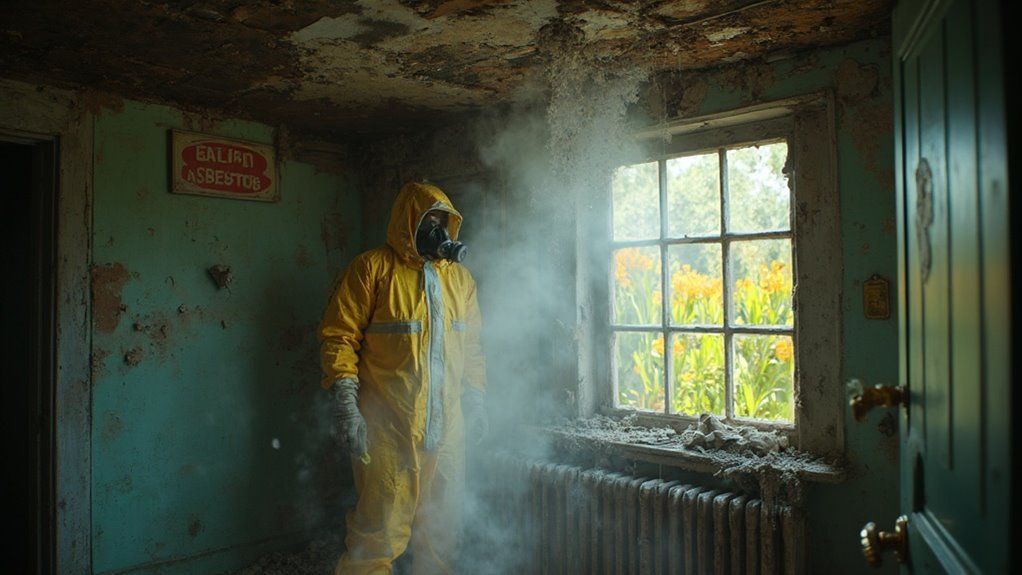Removing asbestos from your property can genuinely save your life. First, it eliminates severe health risks, as exposure can lead to mesothelioma and lung cancer. Second, it protects your property value since buyers often shy away from homes with asbestos, reducing your market leverage. Third, adhering to legal regulations avoids hefty fines and guarantees safety. Fourth, certified professionals possess the expertise required for effective removal, minimizing disruption. Finally, asbestos removal improves long-term health benefits, promoting a safer living environment. By addressing these factors, you'll not only safeguard your well-being but also uncover further insights into the process.
Health Risks of Asbestos Exposure

Asbestos, once hailed for its durability and fire-resistant properties, poses substantial health risks that can have devastating consequences. The inhalation of asbestos fibers can lead to serious diseases, including various asbestos cancers, particularly mesothelioma and lung cancer. These cancers develop because of long-term exposure, often in occupational settings like construction or demolition, where asbestos is still prevalent.
One of the most alarming effects of asbestos exposure is lung scarring, known medically as asbestosis. This condition results from the buildup of scar-like tissue in your lungs, which can cause labored breathing and markedly reduce respiratory function. Over time, the inflammation and scarring can lead to disability or even death. Asbestos-related diseases typically manifest 20 to 50 years after initial exposure, underscoring the delayed consequences of exposure. Regular monitoring and air tests are recommended for known asbestos areas, ensuring a safer living environment.
Furthermore, you should be aware that smokers exposed to asbestos face an even higher risk of developing lung cancer and other asbestos-related diseases. Vulnerable groups include those working with asbestos and their families, along with individuals living near contaminated sites. Understanding these health risks highlights the urgency of asbestos removal, protecting not only your health but the well-being of those around you.
Protecting Your Property Value
A home's value can dramatically decline when asbestos is present, primarily due to the associated health risks and the costly implications of removal. Asbestos detection not only affects property appraisals but can lead to considerable market fluctuations.
| Impact of Asbestos | Benefits of Removal |
|---|---|
| Reduces market value by 5-15% | Increases property value |
| Leads to buyer negotiations | Improves marketability |
| Causes potential legal liabilities | Avoids fines and legal issues |
When potential buyers identify asbestos, their perception shifts, often resulting in reduced offers or demands for price reductions. Conversely, once asbestos is removed, you can position your property more favorably in the market. Not only does this save you from ongoing health risks, but it also mitigates the financial burden associated with removal costs. Providing proof of professional abatement can even serve as leverage, allowing you to command higher prices. Ultimately, addressing asbestos not only protects your health but greatly improves your home's value, making it a strategic investment for your future. Additionally, ignoring the presence of asbestos-containing materials can lead to serious health issues, further impacting your property's desirability.
Legal Compliance and Safety

Removing asbestos not only improves your property's value but additionally guarantees compliance with legal standards designed to protect public health and safety. As a property owner, you have legal obligations to adhere to federal, state, and local regulations governing asbestos removal. This includes engaging certified professionals for inspections and abatement, as well as notifying relevant authorities, such as the New York City Department of Environmental Protection, at least seven days before any removal activities.
Following specific codes, like Industrial Code Rule 56-11.5, is essential for ensuring safety standards during the removal process. Asbestos material must be wetted to prevent fiber release, and proper equipment—such as non-powered hand tools and personal protective gear—must be utilized. Minimizing disturbance of the asbestos is critical, along with proper containment and disposal methods.
Failing to comply with these regulations can expose you to serious health risks, including legal penalties and increased costs for cleanup. Furthermore, non-compliance can lead to environmental contamination, placing further liability on you as a property owner. Prioritizing legal compliance and safety not only protects your investment but also safeguards your community's health.
Professional Expertise in Removal
Effective asbestos removal requires the expertise of certified professionals who understand the complexities of the process. Proper asbestos identification is vital; experienced contractors can accurately pinpoint materials that contain asbestos, guaranteeing safe handling from the start. They employ a variety of removal techniques, including wetting materials to prevent fiber release and sealing them in airtight containers to minimize exposure risks.
Advanced methods and specialized equipment are fundamental for efficient asbestos abatement. Licensed contractors develop thorough removal plans that minimize disruption while prioritizing safety. Techniques like encapsulation may be recommended in some cases, providing a safer alternative to complete removal and often leading to cost savings of 15-25%.
Furthermore, professional contractors guarantee that post-removal support, such as air quality testing, is conducted to confirm that the space is safe for reoccupation. Their extensive training in the latest asbestos removal techniques not only improves safety but also boosts efficiency throughout the process. By entrusting your asbestos removal to skilled experts, you're choosing a path that safeguards your health and well-being, making sure that every step is handled with precision and care.
Long-Term Health Benefits

Long-term health benefits associated with professional asbestos removal are substantial and cannot be overlooked. By eliminating the source of asbestos exposure, you greatly reduce the risk of developing serious health conditions like asbestosis, mesothelioma, and lung cancer. Asbestos symptoms often take years to appear, which means that the earlier you address asbestos issues, the better your long-term health outcome will be.
When you invest in professional removal services, you're not just ensuring a safer environment; you're actively participating in exposure prevention. With statistics showing that at least 30 Americans die daily from asbestos-related illnesses, the urgency of taking action becomes clear.
Moreover, proper asbestos removal safeguards you, your family, and any occupants from future health hazards, contributing to a healthier quality of life. The peace of mind that comes from knowing your living or working space is free from asbestos is invaluable, especially if you have vulnerable individuals like children or elderly relatives.
Frequently Asked Questions
Can Asbestos Exposure Affect Pets or Animals in the Home?
Asbestos exposure can greatly impact pet health, causing respiratory issues and gastrointestinal problems. If you renovate or disturb older materials, be cautious. Protect your pets by minimizing their exposure to potentially contaminated environments.
What Are the Signs of Asbestos-Related Health Issues?
Imagine a silent thief in your lungs, stealing breath. You notice asbestos symptoms like persistent cough, chest pain, or shortness of breath. Understanding these health risks early can protect you from serious, lasting damage.
How Can I Test My Home for Asbestos?
To test your home for asbestos, schedule a professional inspection. They'll collect samples safely for asbestos testing, ensuring accurate results. DIY methods often lack precision and can disrupt hazardous materials, posing unnecessary risks.
Is There a Safe Level of Asbestos Exposure?
Is there truly a safe level of asbestos exposure? Unfortunately, there isn't. Strict safety guidelines exist, but even minimal exposure can lead to serious health risks. It's best to avoid asbestos whenever possible.
What Should I Do if I Find Asbestos in My Home?
If you find asbestos in your home, prioritize safety. Schedule a professional inspection to assess the situation, and consider asbestos removal by certified experts to mitigate health risks and guarantee compliance with safety regulations.
